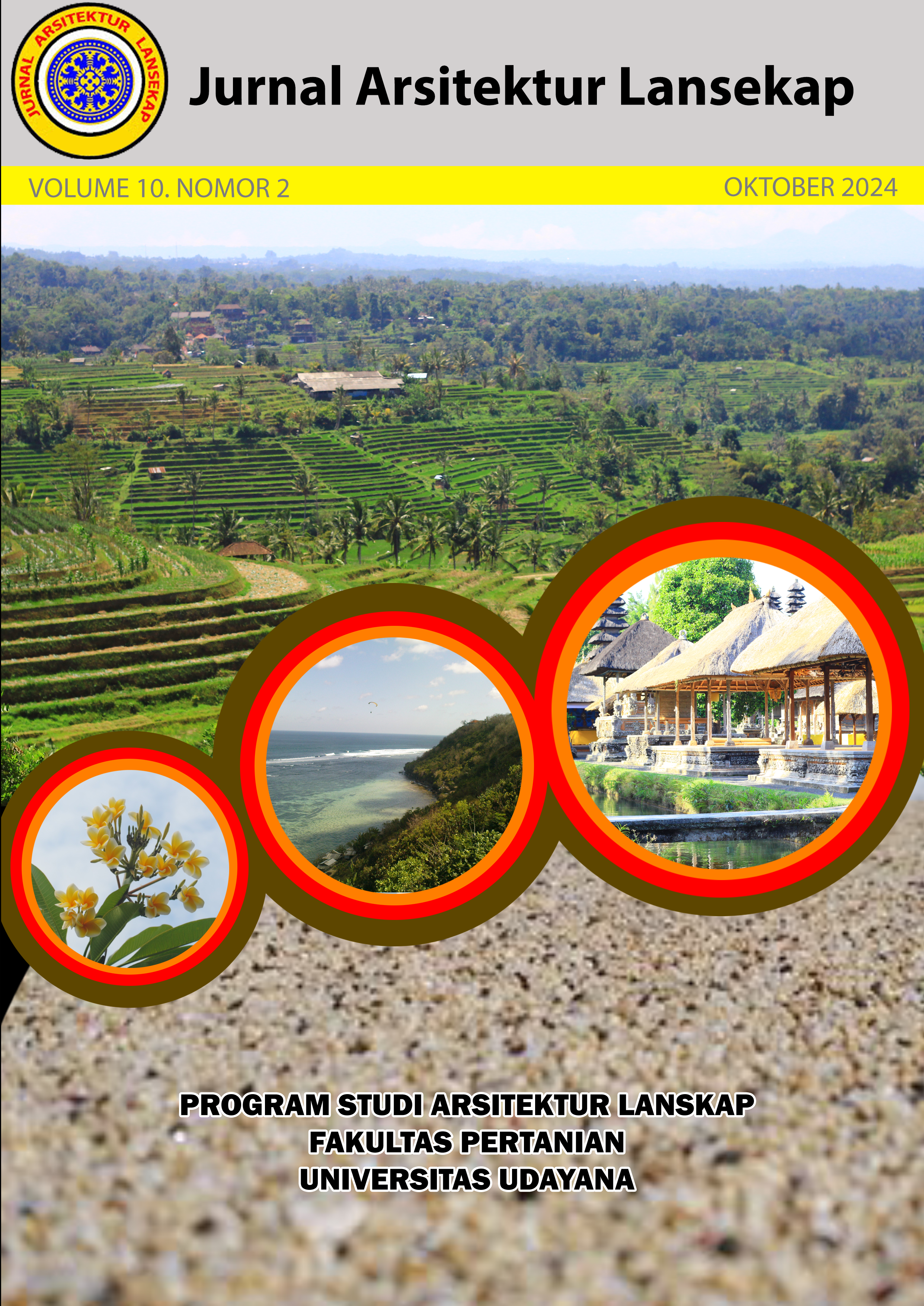Rencana Desain Gale-galean di SD Negeri 29 Dangin Puri Denpasar
Abstract
Playing is the main things for children study. It needs to be inserted by moral values and local culture so that can be delivered and well preserve. Indonesia has aware of importance from playing and built some playing space such as children playground in green space and school which apply a concept of SRA (Sekolah Ramah Anak). inside SRA one importance component is children playground. One of children games/dolanan in Indonesia is gale-galean. Inside gale-galean contains every aspect in outdoor game which stimulate physique, social, cognitive, and emotional development of children. The purpose of this Research is to design gale-galean which located at SD 29 Dangin Puri. Research method has been used was qualitative descriptive which contains 4 systematic element such as: preparation, inventory, analysis, and synthesis. The result of this research is design plan of gale-galean in SD 29 Dangin Puri front yard which use colour dan shape as lines and implement the concept of mandala. Beside that this research consider six criteria in children playground planning. Which is safety, health, comfort, convenience, security, and beauty. This research can be used for preserve gale-galean and beneficial for children grow development.
Downloads
References
Benzaquén, A. (2009). Children at Play: An American History. Journal of The History of The Behavioral Sciences - J HIST BEHAV SCI, 45, 75–77. https://doi.org/10.1002/jhbs.20356
BPS (Badan Pusat Statistik), Kota Denpasar. (2019). Kecamatan Denpasar Timur Dalam Angka Tahun 2019. BPS Kota Denpasar.
Ching, F. D. K. (2007). Architecture (Form, Space, and Order). Third Edit.
Dharmawijaya, Selly. (2018). Gadget dan Anak di Zaman "Now" Ketua TP PKK, Ny. Selly Ajak Memanfaatkan Waktu Luang Bersama. Balipuspa News. Tersedia online pada: balipuspanews.com/gadget-dan-anak-di-zaman-now-ketua-tp-pkk-ny-selly-ajak-memanfaatkan-waktu-luang-bersama.html.
Elicker, J., & Benson, M. (2013). Developmentally appropriate. Young Children.
Fakriah, N. (2015). Pendekatan Arsitektur Perilaku dalam Pengembangan Konsep Model Sekolah Ramah Anak. www.sekolahramahanak.com Vol. 1, No. 2, September 2015 | 1, 1(2), 1–14.
FAO (Food and Agriculture Organization of United Nation). (2017). Inilah Tinggi Badan Anak Indonesia sesuai Usianya. Klikdokter. Tersedia online pada: klikdokter.com/ibu-anak/kesehatan-anak/. (diakses pada Maret 2022).
Hamzah, A. A. (2016). Rencana Kerja Pembangunan Kota Denpasar Tahun 2016. 1, 5.
Gold, S. M.(1980). Recreation, Planning, and Design. The McGraw-Hill Companies. New York.
Izza, S., Nurizqi, T. L., & Ayuningrum, R. D. (2018). Permainan Tradisional (Gobak Sodor) Dalam Membangun Karakter Cinta Tanah Air Pada Anak. Prosiding Seminar Nasional “Penguatan Pendidikan Karakter Pada Siswa Dalam Menghadapi Tantangan Global,” 0291, 80–85.
Kementerian Pemberdayaan Perempuan dan Perlindungan Anak. (2014). Peraturan Menteri Negara Pemberdayaan Perempuan dan Perlindungan Anak Republik Indonesia Nomor 8 Tahun 2014 Tentang Kebijakan Sekolah Ramah Anak. 1–30. https://doi.org/10.1016/j.gaitpost.2018.03.005.
Republik Indonesia. (2017). Undang-undang Republik Indonesia Nomer 5 Tahun 2017 tentang Pemajuan Kebudayaan. Bab 1 Pasal 5, Objek Pemajuan Kebudayaan
Sugiyono. (2005). Metode Penelitian Kuantitatif Kualitatif dan R&D. Bandung: Alfabeta.

This work is licensed under a Creative Commons Attribution-ShareAlike 4.0 International License.
An author who publishes in the Jurnal Arsitektur Lansekap (JAL) agrees to the following terms:
- Author retains the copyright and grants the journal the right of first publication of the work simultaneously licensed under the Creative Commons Attribution-ShareAlike 4.0 License that allows others to share the work with an acknowledgement of the work's authorship and initial publication in this journal
- Author is able to enter into separate, additional contractual arrangements for the non-exclusive distribution of the journal's published version of the work (e.g., post it to an institutional repository or publish it in a book) with the acknowledgement of its initial publication in this journal.
- Author is permitted and encouraged to post his/her work online (e.g., in institutional repositories or on their website) prior to and during the submission process, as it can lead to productive exchanges, as well as earlier and greater citation of the published work (See The Effect of Open Access).
Read more about the Creative Commons Attribution-ShareAlike 4.0 Licence here: https://creativecommons.org/licenses/by-sa/4.0/.







